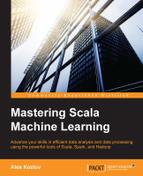We have seen classification trees in the previous chapter. One can build a recursive split-and-concur structure for a regression problem, where a split is chosen to minimize the remaining variance. Regression trees are less popular than decision trees or classical ANOVA analysis; however, let's provide an example of a regression tree here as a part of MLlib:
akozlov@Alexanders-MacBook-Pro$ bin/spark-shell Welcome to ____ __ / __/__ ___ _____/ /__ _ / _ / _ `/ __/ '_/ /___/ .__/\_,_/_/ /_/\_ version 1.6.1-SNAPSHOT /_/ Using Scala version 2.10.5 (Java HotSpot(TM) 64-Bit Server VM, Java 1.8.0_40) Type in expressions to have them evaluated. Type :help for more information. Spark context available as sc. SQL context available as sqlContext. scala> import org.apache.spark.mllib.tree.DecisionTree import org.apache.spark.mllib.tree.DecisionTree scala> import org.apache.spark.mllib.tree.model.DecisionTreeModel import org.apache.spark.mllib.tree.model.DecisionTreeModel scala> import org.apache.spark.mllib.util.MLUtils import org.apache.spark.mllib.util.MLUtils scala> // Load and parse the data file. scala> val data = MLUtils.loadLibSVMFile(sc, "data/mllib/sample_libsvm_data.txt") data: org.apache.spark.rdd.RDD[org.apache.spark.mllib.regression.LabeledPoint] = MapPartitionsRDD[6] at map at MLUtils.scala:112 scala> // Split the data into training and test sets (30% held out for testing) scala> val Array(trainingData, testData) = data.randomSplit(Array(0.7, 0.3)) trainingData: org.apache.spark.rdd.RDD[org.apache.spark.mllib.regression.LabeledPoint] = MapPartitionsRDD[7] at randomSplit at <console>:26 testData: org.apache.spark.rdd.RDD[org.apache.spark.mllib.regression.LabeledPoint] = MapPartitionsRDD[8] at randomSplit at <console>:26 scala> val categoricalFeaturesInfo = Map[Int, Int]() categoricalFeaturesInfo: scala.collection.immutable.Map[Int,Int] = Map() scala> val impurity = "variance" impurity: String = variance scala> val maxDepth = 5 maxDepth: Int = 5 scala> val maxBins = 32 maxBins: Int = 32 scala> val model = DecisionTree.trainRegressor(trainingData, categoricalFeaturesInfo, impurity, maxDepth, maxBins) model: org.apache.spark.mllib.tree.model.DecisionTreeModel = DecisionTreeModel regressor of depth 2 with 5 nodes scala> val labelsAndPredictions = testData.map { point => | val prediction = model.predict(point.features) | (point.label, prediction) | } labelsAndPredictions: org.apache.spark.rdd.RDD[(Double, Double)] = MapPartitionsRDD[20] at map at <console>:36 scala> val testMSE = labelsAndPredictions.map{ case(v, p) => math.pow((v - p), 2)}.mean() testMSE: Double = 0.07407407407407407 scala> println(s"Test Mean Squared Error = $testMSE") Test Mean Squared Error = 0.07407407407407407 scala> println("Learned regression tree model: " + model.toDebugString) Learned regression tree model: DecisionTreeModel regressor of depth 2 with 5 nodes If (feature 378 <= 71.0) If (feature 100 <= 165.0) Predict: 0.0 Else (feature 100 > 165.0) Predict: 1.0 Else (feature 378 > 71.0) Predict: 1.0
The splits at each level are made to minimize the variance, as follows:

which is equivalent to minimizing the ![]() distances between the label values and their mean within each leaf summed over all the leaves of the node.
distances between the label values and their mean within each leaf summed over all the leaves of the node.
..................Content has been hidden....................
You can't read the all page of ebook, please click here login for view all page.
